Velyan's house in Bansko - a story about the love of Usta Velyan and Sofia Benina
- Stefan Ivanov

- Nov 2, 2023
- 15 min read
Updated: Jan 20, 2025
Once upon a time in Bansko there was a house whose rooms were wonderfully painted with wonderful and lovely paintings, its stone walls were masterfully painted with unique whimsical fairy ornaments, and suns carved from wood smiled from the ceilings.
fine paints,
various forms
twists and turns,
unique, interesting, and wonderful!
Love!
It is said that it was love - true, eternal, unquenchable, indestructible, unfading, unquenchable, strong, eternal, holy, that inspired the author of these exquisite frescoes to create them!
The wonderful house is still preserved today, and its famous wall painting shines and shines brighter than the stars in the sky and tells about the love of Usta Velyan and his beloved - Sofia Benina!

This is the Velyanova house in the city of Bansko!
Today it has been turned into a museum and every guest of this wonderful Pirin paradise can visit it and dive into the wonderful world of love!
So did I!
Dear friends, I also visited her
and I was convinced of her wonderful miracles!
I stepped through her door
and I breathed in the wonderful aroma of the flowers by the alley!
I climbed the wooden stairs to the veranda,
while Pirina faced me great gray slopes.
I toured the rooms of the Velyanova house
and feelings deep and strong I experienced!
And I gasped in amazement at what love had done
and I felt joy in my heart!
And now I will convey these feelings to you
and I will tell you about the love of Velyan and Sofia!

The Velian house was built in the period XVIII century ÷ XIX century and accordingly has all the typical features of the family house-fortress, characteristic of the revival construction of this period.
Why castle-houses you will probably ask, and I will give an answer in rhymes?
It was a hard time then - slave
the critters ran amok in this paradise –
looted, burned, robbed violently
and Bulgarian tears had no end!
Strong walls if you raise
you can save your life.
And tunnels of secrets if you dig,
along them you will escape to the mountain.
At that time, Bansko became famous as a famous commercial center. Banskalii quite successfully traded cotton, tobacco, wine, poppy, as well as various spices from the lands near the White Sea in the direction of Western Europe. From there, they in turn bought weapons and manufactured goods for the Ottoman Empire, thus accumulating considerable wealth for their time.
But where there are riches,
bad things happen soon!
Evil robbers are coming
gold to steal.
You can't keep your property
from evil eye robbers!
The wealthier Bulgarians built sturdy massive houses with high stone walls. The woodwork was completely filled with black brick, there were metal bars on the windows, the gates were huge and massive, there were battlements in the middle of the walls, and between the walls - secret places that led outside the settlement through a network of underground and above-ground corridors.
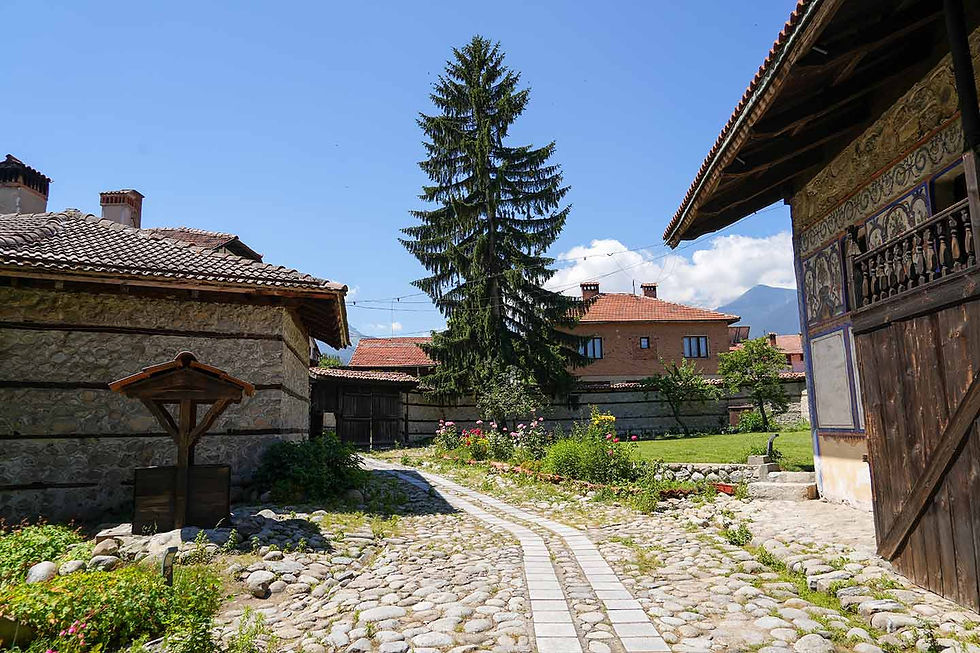
Velyanova is just such a house-fortress.
It was built by the wealthy cotton merchant Ivan Hadjiradonov, who, becoming incredibly rich, decided to build a wide, massive and strong house-fortress for his family.
There are several different hypotheses as to why Ivan Hadjiradonov is selling the house.
One of them tells how soon after the house was completed, the owner's business suffered and he sold it to the municipality.
Another story claims that on one of the merchant's journeys robbers attacked his home and his wife, left alone, ran through the cache, falling and badly injured. Soon after what happened, she died, and the grieving husband never returned here, because the house reminded him too much of his beloved.

Meanwhile, very close by, another wealthy banskalia and mayor of the Bulgarian municipality at that time - Lazar German*, cousin of Neophyte Rilski, took on the difficult task of erecting an incomparable in beauty and grandeur Bulgarian Christian temple, today a cultural monument - the church of St. Trinity".
*Lazar Todorov (Teodorovich) German Golev is a Bulgarian revivalist, merchant, owner of a commercial office in Vlasko.
Together with his brothers, Lazar Germani opened the trading and banking house "Germani Brothers" in Bucharest, which has branches in Vienna and Venice. He gradually became one of the richest merchants and had great influence among the Ottoman authorities. Maintains connections with Zemun, Belgrade, Pest, Vienna, Paris and Nuremberg.
Dedo Lazo, as he is known at home in Bansko among his friends, relatives and acquaintances, was the main leader of the process of building the temple, as well as the face of the difficult negotiations with the Ottomans, which ultimately cost him his life.

The Holy Trinity Church was completed in 1835, and grandfather Lazo needed someone to paint it, as well as to make the church iconostasis, that's why he invited the main character of our story - Treson** Velyan Ognenov Darkoski, known as Usta Velyan .
**The main and most widespread version until recently, repeated in a number of encyclopedic publications, is that Velyan Ognev was born in the village of Tresonche, Debar, Miass.
Another hypothesis connects his birthplace with the neighboring village of Osoy, Miass.
However, Kostadin Molerov, a descendant of Banská painters, writes: "Velyan Ognev, an immigrant from Lazaropole, was a carver in the church of St. Trinity" in Bansko, together with Ivan Ushev".
Ivanka Gergova cites pictorial inscriptions from two icons to prove that Ognenov's birthplace is indeed a third village in Miass - Lazaropole.
This is how it becomes clear that Ognenov is Usta Velyan's patronymic, and his surname is Darkoski - one of the oldest Lazaropol surnames.
The invitation to Usta Velyan to work in Bansko proves that he is already a well-known and proven master. Various publications mention that he already worked in Thessaloniki, Siarsko and Drama.
Velyan was gifted with a gift
to turn everything into a miracle
as soon as a brush is used.
Drawings so wonderful
he could create
and every living soul
she raved about his craftsmanship!
The information about Usta Velyan about the time before he came to Bansko is too scarce.
He was probably born shortly before the beginning of the 19th century.
His descendants tell of him that he had as his wife an Italian woman named Juliana, with whom he traveled extensively in Europe, and who died before his removal to the foot of Pirin. Master Velyan responds to his invitation with his sons - Angel and Traiko, who help him a lot in the work on the church, which means that his sons are already grown up and have learned their craft. He also mentions a tragic incident – one day while working in the church, his boy Traiko fell from a high scaffolding he was working on and died.
The leaders of the city marveled at his zeal for work so much that, deeply satisfied, they donated Ivan Hadjiradonov's house to him.
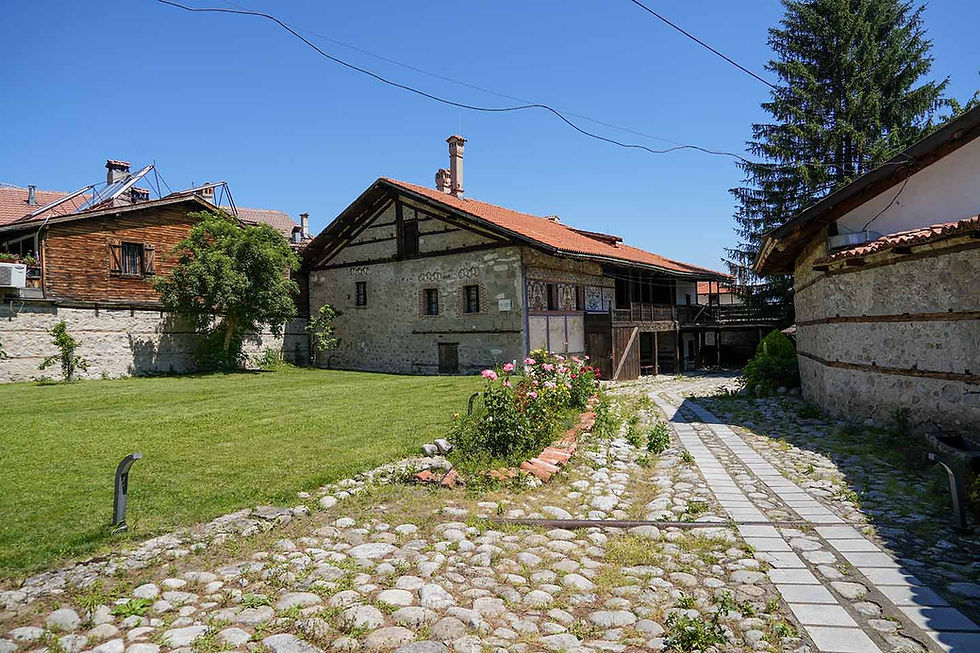
The new owner, Usta Velyan, breathes new life into the house, which is henceforth known as the Velyan House.
Velyan Ognev meets his great love in Bansko - Sofia, daughter of Pope Peter Benin and sister of Neofit Rilski - patriarch of Bulgarian teachers and writers.
In order to prove to you that Sofia is the great love of Usta Velyan, now I will most kindly invite you to enter together through the large massive wooden gate of the Velyan house, to walk along the alley, along which a dozen amazingly beautiful sunny smiles bloom, to climb up the wooden stairs to the wide and airy porch and look at all the rooms - one by one.
Come on, shall we go?
It's a hot, sunny summer day in Bansko today, and I walk through the doors of Usta Velyan's house, not expecting the strange uniqueness that will suddenly strike me.

The yard is huge, magically colorful and soothingly green!

A green lawn rests my gaze while dozens of sunny smiles caress all my senses and play playfully in front of my camera lens.
I capture everything for you, dear friends! At the end of the post, you will find the traditional link to the special photo album, which has collected the charm of this impressive Pirin place, captured through my eyes, which makes it even more special!
I arrive in front of the tall stone house and begin to examine the sculpted masterpieces with inquisitive interest.
A hand magically guided by love
she painted everything here.
My eyes are running through the colors
looking for a memory, a sound.
How magical everything is -
beauty in harm's way!
Not just a house! This is home
of love and respect!
A master painter through the brush
he expressed his love here.
And he left a memory for us
for Sofia – in his heart,
he wrote songs for her
on the walls of the home.
It is beautiful! Indeed! I look at these wall decorations and it's like going back to those times.
Has it happened to you? It is as if you are transported centuries back to the time when this house was young and life was different. And it's as if I see Usta Velyan standing right here by the wall - with a brush in his hand, anointed with different paints to create, and Sofia is standing on the porch and smiling at him.
And he smiles back at her!
And their eyes sparkle with love!
This was their home. They were happy here. They loved each other very much and this love is visible in every room, from every wall, from every ceiling, from every paint, from the paintings of Venice and Constantinople.
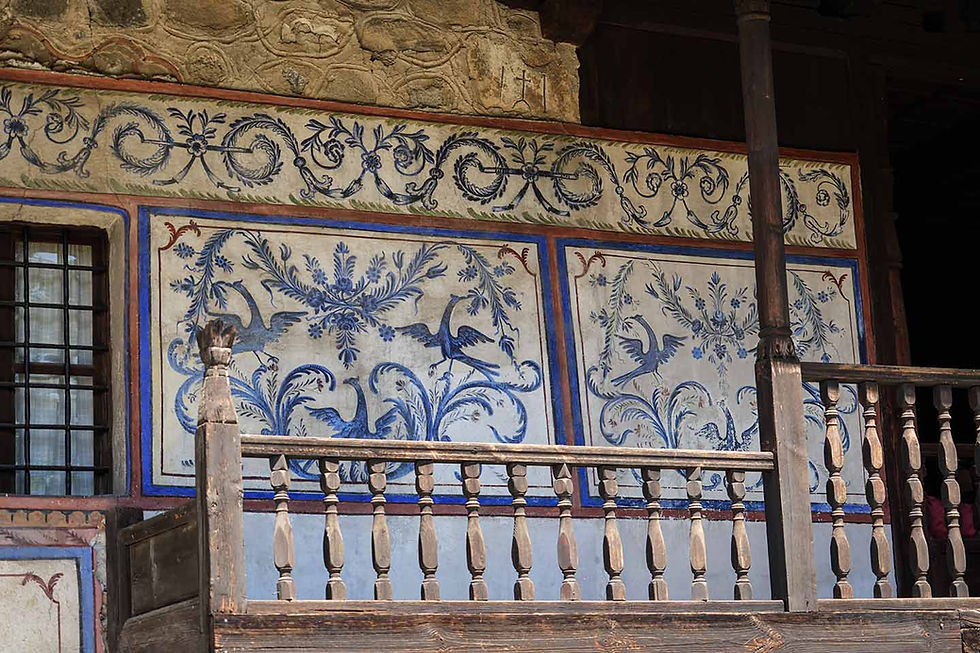
The veranda is huge - wide, beautiful and with a wonderful view of Pirin. The kiosk invites me to stop for a moment and stretch my legs in the summer silence. Tempted, I hesitated.
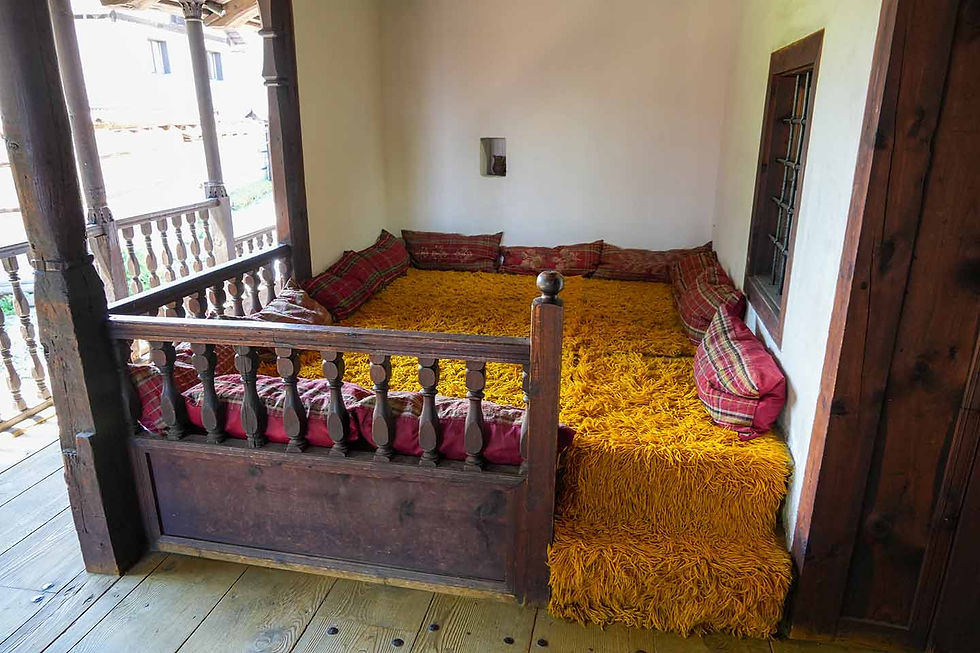
The sun is shining over the veranda!
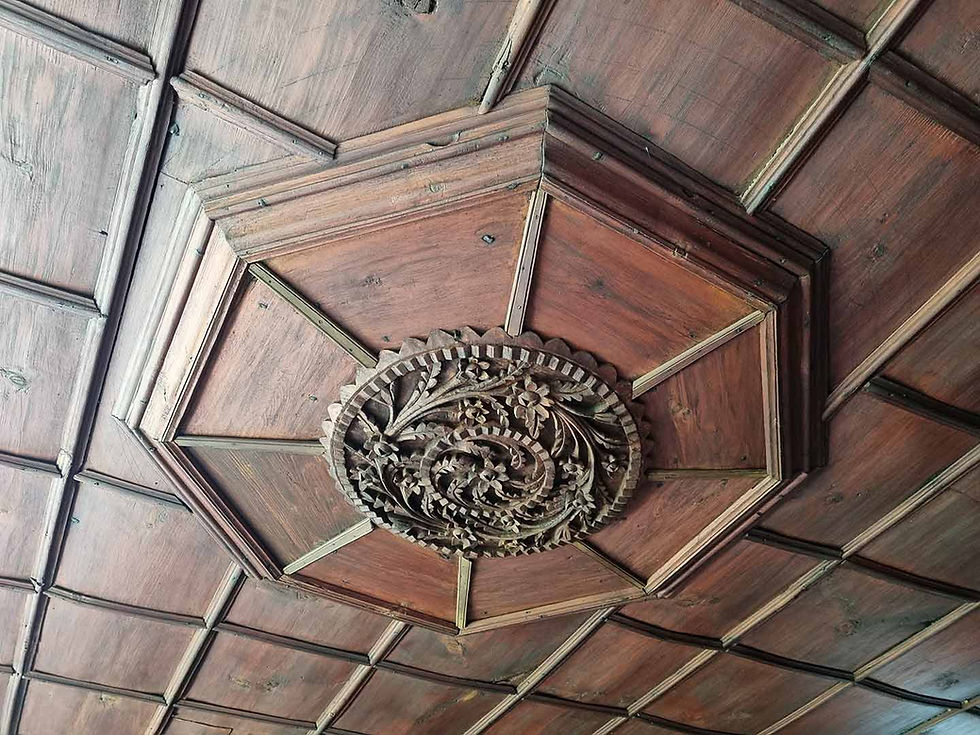
There are five rooms in which the happy family lived.
First, I enter the guest room - a bed room, as the locals call it. This is the most honorable room in the house, the most spacious and the sunniest.
The lion is a symbol of freedom.
The motif with the two pehlivans and the two musicians next to them is similar to a scene from 1795 from the drawing room of the Sersky Monastery by the painter Nedelko.
It is believed that by painting one of the few specimens of the animal world that create families for life, Usta Velyan wanted to show his deep affection and love for his wife. Or to put it another way: the pair of wolves symbolize the family and the strong relationship between Sofia and Velyan.
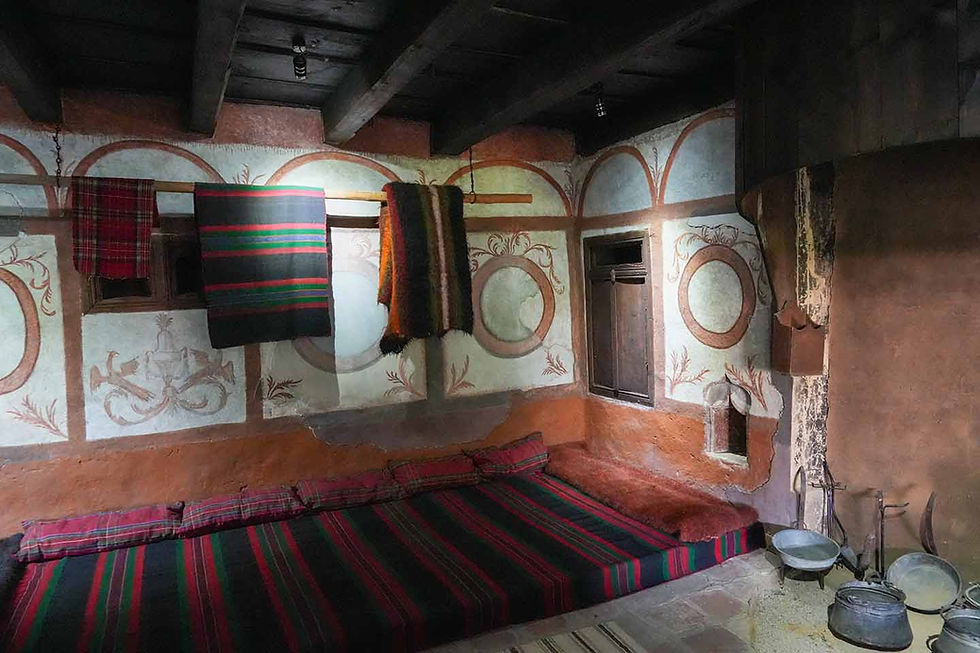
Next is the common room - living room, kitchen and bedroom in one, they call it kashchi in Bansi. Here is a large hearth in which delicious feasts were simmering, the aroma of which wafted around.
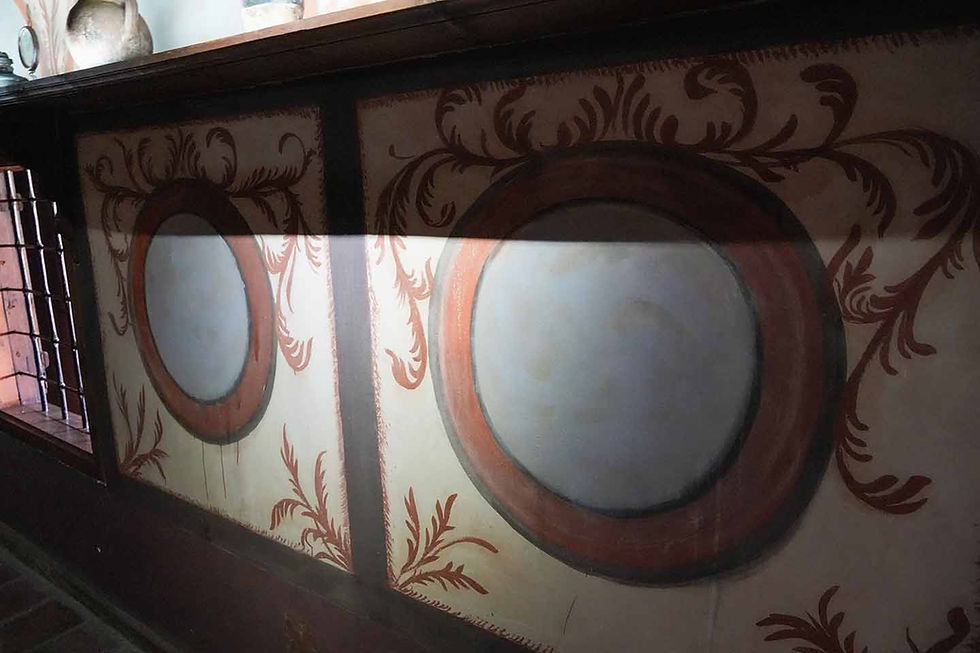
What a clever trick the Debar master of the brush has introduced here in this room! Since the room is slightly dark and not much light enters it, Usta Velyan paints large round mirrors on the walls, which opens up the room and gives a special sense of volume.
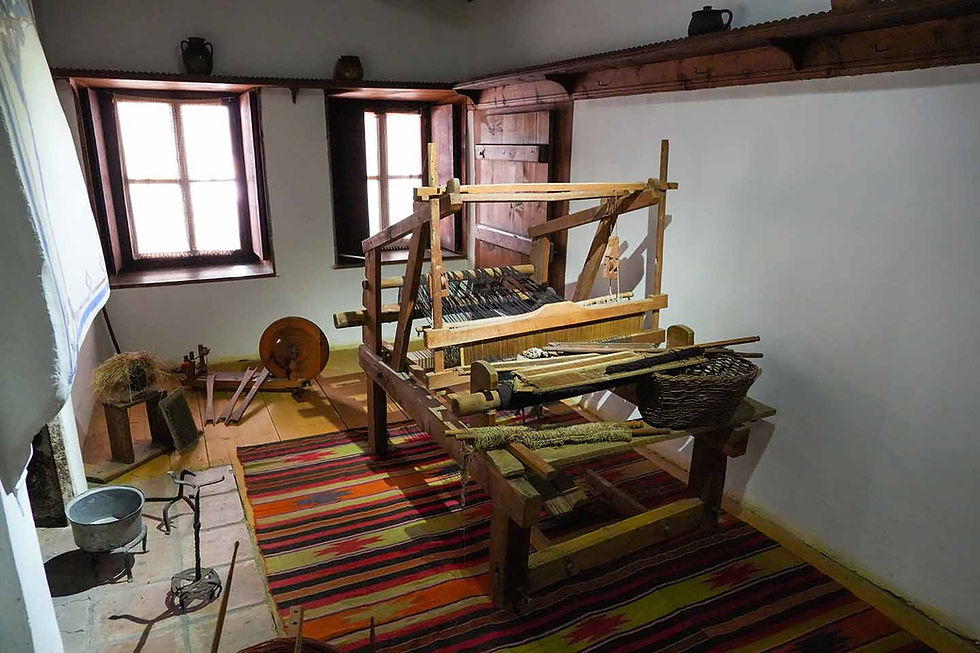
From it you enter the women's room - a significantly smaller workroom, where I find a loom on which skilled hands have been weaving, a wheel with a hook and a spindle, as well as an old chest.
Well, yes, that's right - the Bulgarian woman, besides being gifted with beauty, is very skilled! She did everything herself - she knew how to cook, knit, weave, embroider, knit, sew, make beautiful embroideries, look after children, feed her husband and run the whole house!
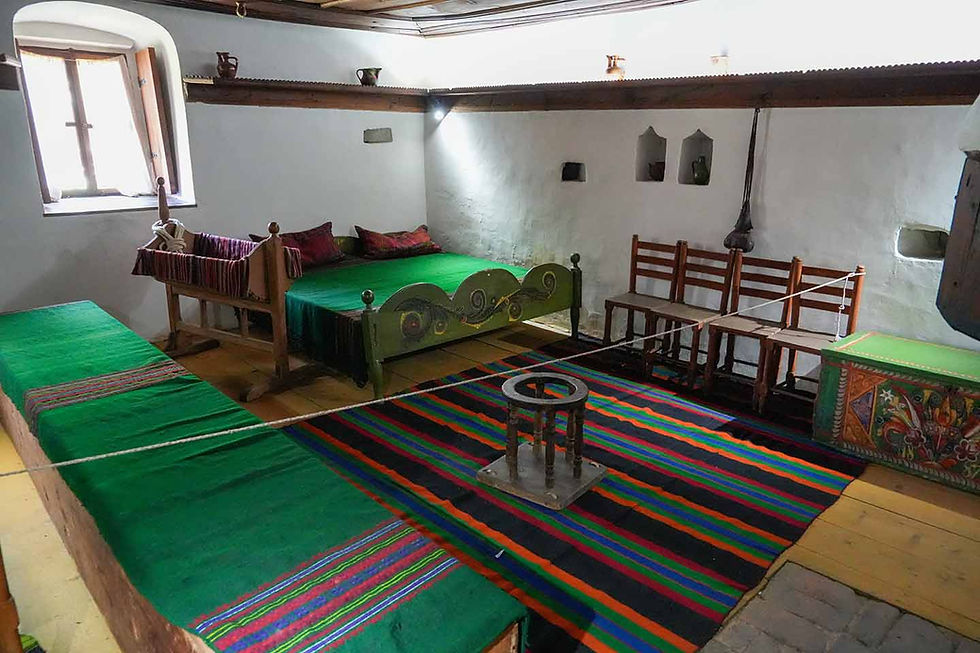
And at the bottom there is a small room that is special – it is for the mother and the newborn, where they had to be separated from the rest of the family for at least the first 40 days to protect the baby.

The opening leading to the cache is also located here. At the time, there were two tunnels - one led to the church yard, and the other - to the neighboring Sirlestova house and from there through a third tunnel - outside the settlement.

With the accumulation of wealth and culture, Usta Velyan, and in general all the merchants of Banskalia, became quite rich, and he did something unheard of at that time - he blocked off part of the veranda and created an internal bathroom and toilet, a real rarity and an impressive luxury for the 18th century.
The blue room
I leave it for last.
It hides a valuable mural decoration
and I will arrange it in rhymes.
The blue color predominates here
it will probably be fun for Sofia.
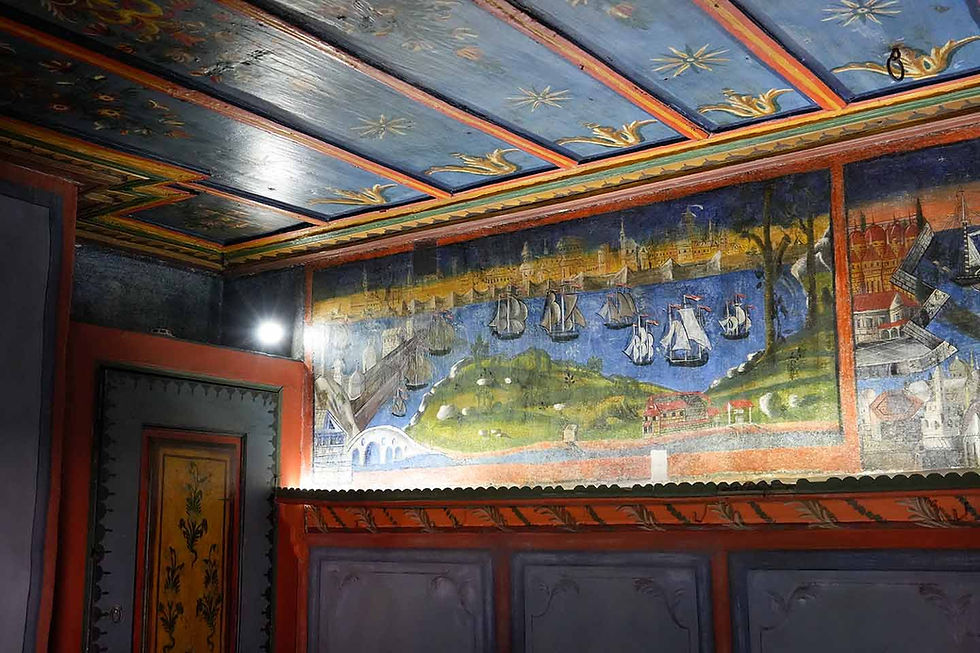
Venice beautiful amid the waves floats!
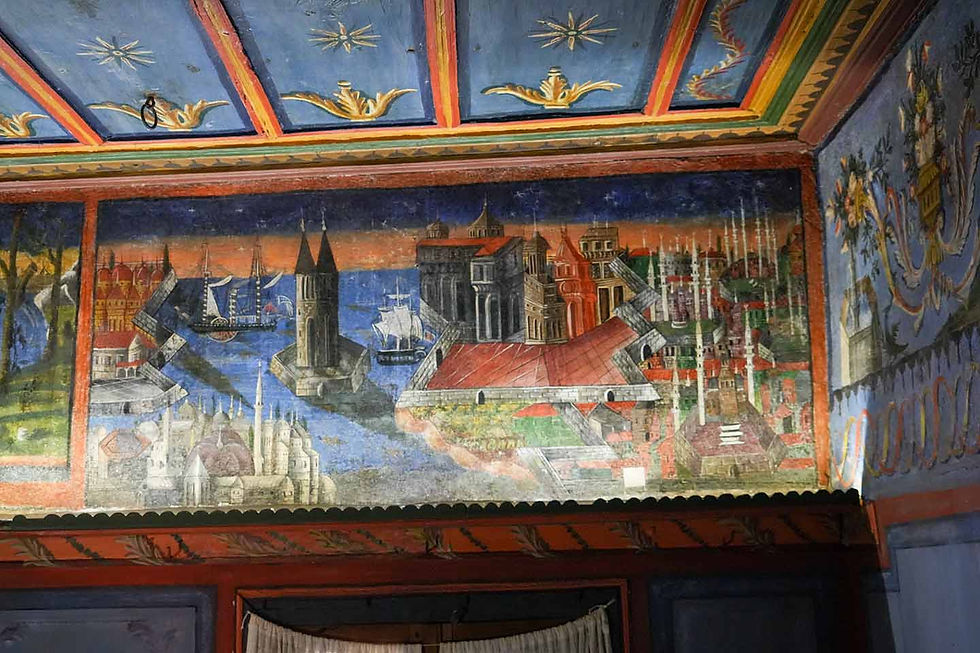
The towers of Constantinople shine in the sky!
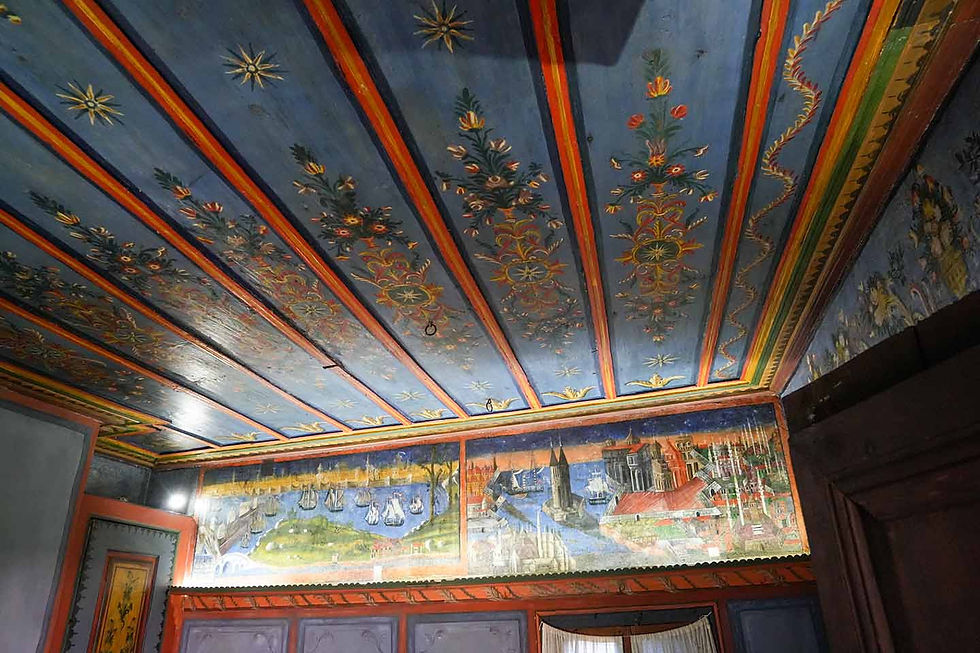
Wind blows the white sails
light ships in the middle of the sea go crazy!
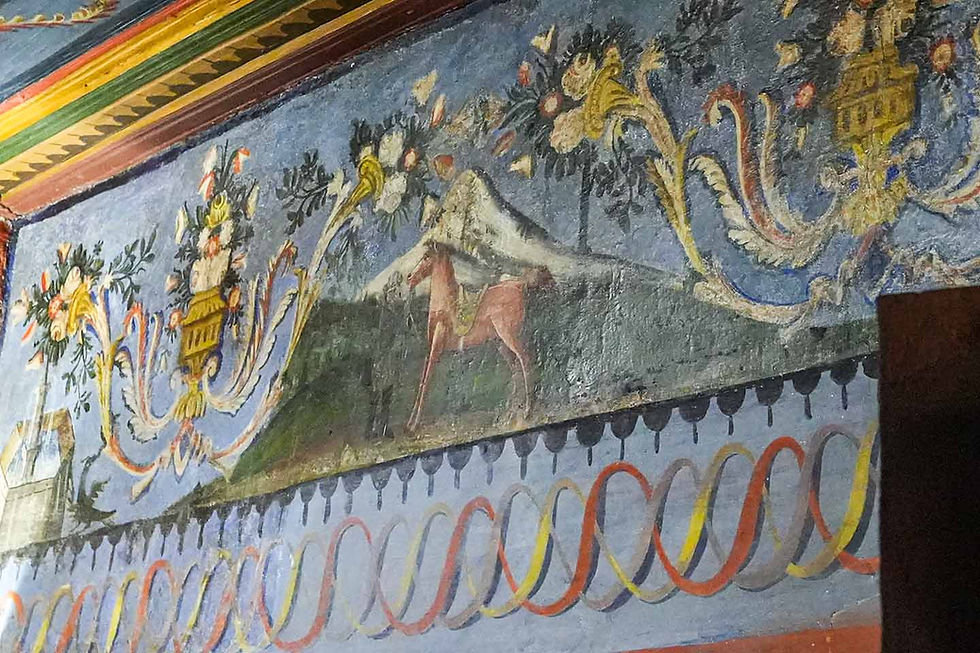
Velyan himself is painted there
the horse holds its own reins.
All this floats in his memories
and he recreates a sun to shine
a wide smile on Sofia's face
in her most personal room as if by magic.
And all this is beautiful, no doubt,
probably inspired by love big!
I was wondering what this is?
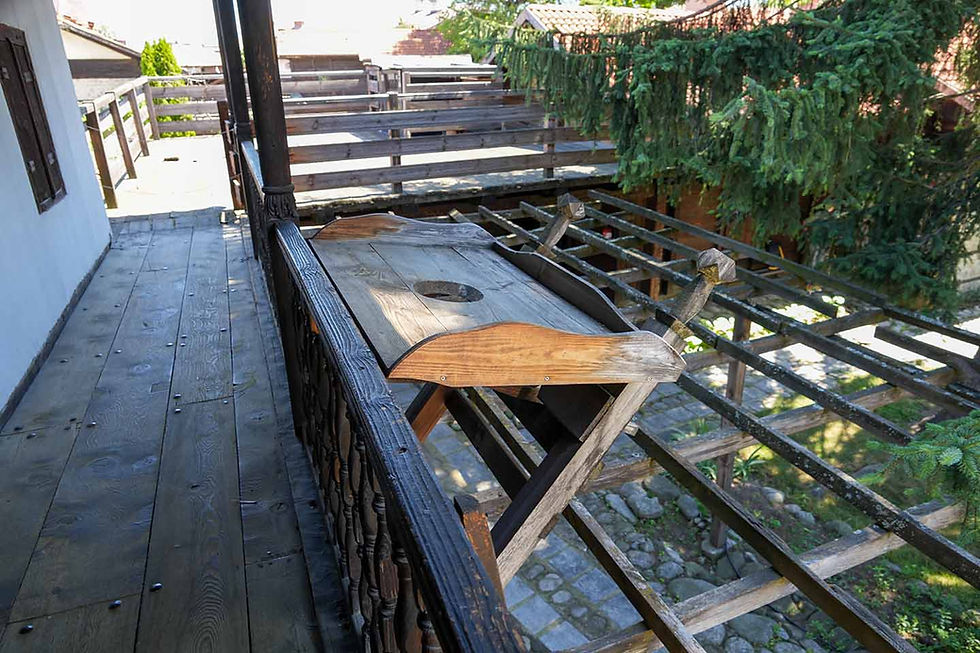
A practical wooden sink with an opening in the middle, through which the unnecessary parts of the prepared fruits and vegetables for soups, dishes and salads fall directly into the stone trough below - for the animals.
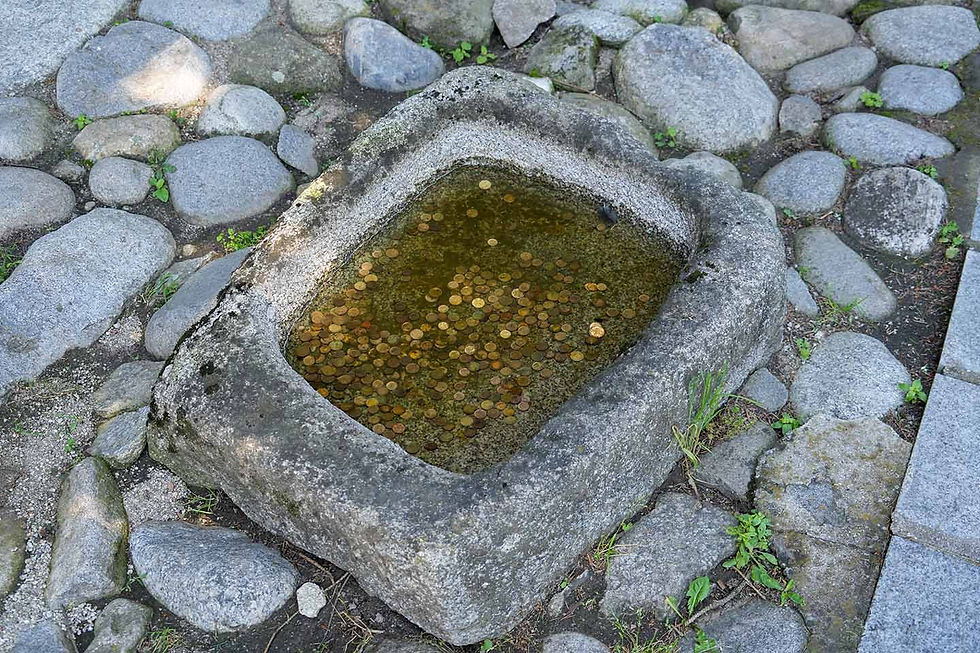
The typical terrace that connected the house with the economic part, which is called a hut, also served as a shed for the animals. From there you can see a fabulous view of the majestic Pirin and its snowy peaks.
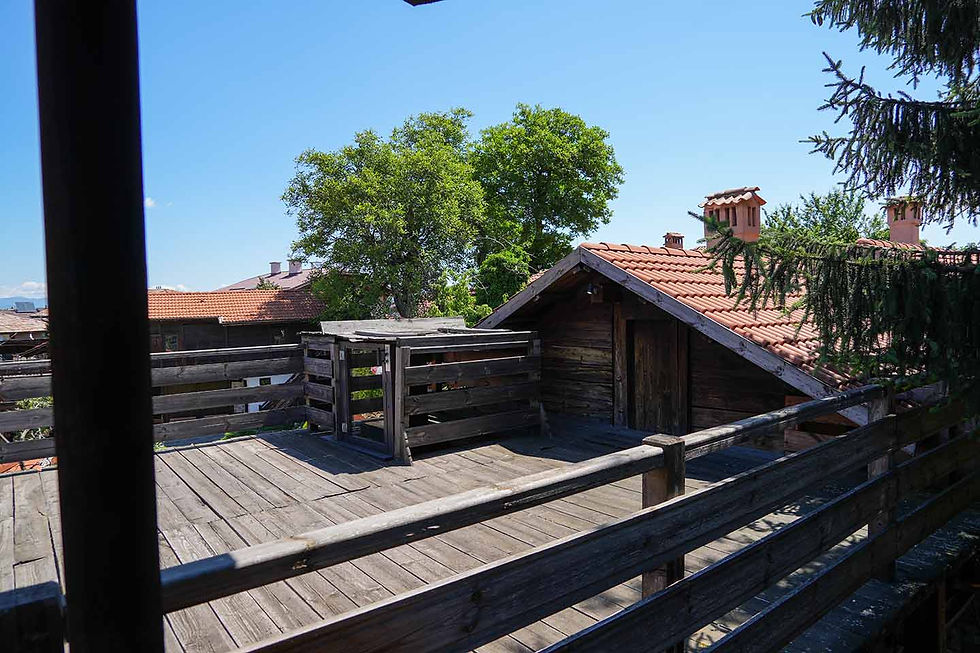
This is the Velyanova house in the city of Bansko.
This is the expression of Usta Velyan's love for his Sofia, wonderfully illustrated and told to us here - forever!
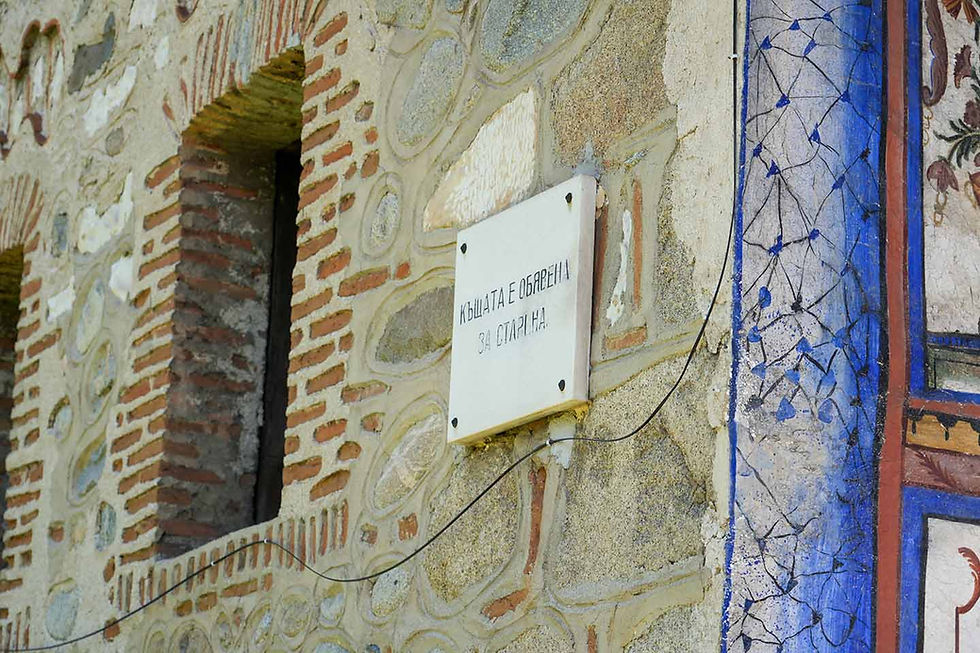
The Velian house was declared a cultural monument of national importance in issue 87 of the State Gazette in 1967.
In 1977, the house was opened for visitors.
Dear friends, I was so impressed that I wrote in rhymes - all the verses in this post are mine, deeply inspired by what I saw, told, felt, experienced, felt.
How to get to the city of Bansko?
Bansko is a city in Southwestern Bulgaria, the administrative center of Bansko municipality, Blagoevgrad district.
Bansko is located at the foot of the Northern Pirin at 927 meters above sea level. It is 56 kilometers from the regional town (about 56 minutes by car).
The Glazne River flows through Bansko.
The climate in the area is mountainous and allows the retention of the snow cover from December to April, and the alpine character of Pirin Mountain provides excellent conditions for professional and amateur skiing.
Bansko is a stop on the Septemvri - Dobrinishte narrow gauge railway route.
Bansko stands at:
156 kilometers (about 1 hour and 51 minutes by car) from the capital
146 kilometers (about 2 hours and 30 minutes by car) from the city of Plovdiv
512 kilometers (about 6 hours and 23 minutes by car) from the city of Varna
396 kilometers (about 4 hours and 30 minutes by car) from the city of Burgas
How do you get to the "Velyanova House" museum?
Museum "Velyanova House" is located not far from the Church of the Holy Trinity at 7A Velyan Ognev Street.
Museum "Velyanova Kashta" in the city of Bansko is object number 1 of the 100 national tourist objects of Bulgaria.
What can be visited nearby?
Bansko is an amazing city, full of history, immense beauty and magnificent sights!
In Bansko I recommend:
to walk the old narrow cobbled streets of the Old Town
to walk Gotse Delchev Street
to take a picture in front of the city's sundial
to look at the stone pages of the "Slavic Bulgarian History" unfolded around the monument of Paisius
to sit in the shade under the majestic crown of the ancient tree
to learn the history of Khachkar monument
to hear the bells of the bell tower of the Holy Trinity Church
to take a sip of fresh Pirin water from the numerous stone fountains of the Old Town
to visit the temple "St. Venerable Paisius Hilendarsky"
to visit the house-museum "Neofit Rilski"
take a look at the museum complex "Nikola Vaptsarov"
to honor Vaptsarov's poems in front of his monument and on the square bearing his name
to visit the poet's native house
to see the accurately recreated cell of Paisius in the spiritual-historical center "St. Paisius Hilendarski"
to enjoy amazing panoramas towards Pirin from the panoramic platform of Bansko
In Bansko there is the Bansko Gondola.

The most popular ski resort in Bulgaria - Bansko has comfortable and safe lifts that guests of the city can use all year round.
At the disposal of the residents and guests of the resort are two six-seater, six four-seater, two two-seater lifts and one cabin lift, which is also the most attractive and preferred lift in the city.
The cabin ropeway "Bansko - Banderishka Polyana" has a route length of 6,233 meters, which ranks it in second* place in length.
*The championship is held by the Simeonovska ropeway on Vitosha, which has a track length of 6720 meters.
The gondola, as the Bansko gondola lift is also called, was manufactured by the Austrian company Doppelmayr in 2002 (today's Austrian-Swiss company Doppelmayr-Garaventa) and was put into operation in 2003.

The route through which the lift passes has a height difference of 597 meters, and the capacity of the facility is about 2,000 people per hour.
There are three stations on the eight local Bansko cable car - lower (initial), intermediate and upper (end).
The lower (starting) station is located at 998 meters above sea level and is about 2.5 kilometers from the center of Bansko.
At the lower station of the lift, there are also the cash desks, from which tickets and cards for using the lift can be purchased.
The intermediate station is located in the area of Chalin Valog at 1468 meters above sea level.
Here, tourists have two options – either get off the lift to walk and descend the slopes of Chalin Valog, or continue to the upper station of the lift.
The last part of the cable car route starts from the intermediate station "Chalin Valog" to Banderishka Polyana.

The Banderishka Polyana area, where the upper (end) lift station is located, is one of the most attractive places for summer and winter tourism in the Pirin Mountains.
How do you get to the Bansko Gondola?
Very close, only 5 kilometers north of Bansko (about 8 minutes by car), you will find the village of Banya, Razlozhko - the richest village in mineral springs in Bulgaria!

In the village of Banya, you can visit the Old Bulgarian Bath, built in the Roman style.

In the village of Banya, you can explore the old Turkish Murtina bath (Ottoman hammam).

In the village of Banya you can see the monument of Neofit Rilski.

8 kilometers east of the city of Bansko (about 9 minutes by car) is the charming jewel of Dobrinishte.

In Dobrinishte, I suggest you take another incomparable walk and visit the town's Balneolechebnitsa, next to which a wonderful and green park has been built.
The Church of St. St. Apostles Peter and Paul is exquisite, beautiful and I suggest you take a look at it during your walk.

The center of Dobrinishte is beautiful and offers tranquility, charm and beauty to its visitors.

Only 6 kilometers northwest of Bansko (about 10 minutes by car) is the wonderful Razlog.

In Razlog, I suggest you take the "Steps".
From the place you will have the magnificent opportunity to enjoy an amazing view of three mountains - the beautiful Pirin, the exquisite Rila and the proud Rhodopes.
The green, orderly, colorful, fresh and incredibly beautiful city park of Razlog is also a place you should not miss to visit.
A walk around the city will calm, amaze and impress you, so just do it.
Only 21 kilometers north of the city of Bansko (about 24 minutes by car) you will find the picturesque Rila village of Dobarsko. A walk here is an immense pleasure and you should not miss it!

In the village there is a unique national cultural monument - the Church of St. St. Theodore Tiron and Theodore Stratilatus in Dobno, which I think is too famous to invite you to visit it, because you probably already have.

And perhaps you are looking for attractions and daring entertainment?! If so, the bear park above Belitsa, nestled in the beautiful Rila forests, is just for you!
Just 20 kilometers northeast of the city of Bansko (about 24 minutes by car) is beautiful Belitsa.

About 12 kilometers northeast of the town of Belitsa (about 22 minutes by car) along a narrow and in some sections rather dusty road in the bottom forests of Rila, there is a bear park that I invite you to visit.
Certainly around the city of Bansko you can visit all the high-quality and very interesting sites, eco-paths, routes and places. I will advise you to take the road leading to Vihren hut.
At the side of the road, look around for a detour by the incredibly beautiful, fresh and impressively beautiful river Demyanitsa.
Demyanitsa is a river from the Mesta basin, which collects the waters of six lake groups - Vasilashki, Valyavishki, Prevalski, Tipitski, Kirkamski and Gazeiski lakes. Under the name Valyavitsa, it originates from the Valyavish Lakes at 2,400 meters above sea level. It initially flows west, but after passing through the Tiyatsite area, it heads straight north. Its catchment area is estimated at 37 sq. km. The average slope is 102 per mille, that is, for every kilometer of linear length, the river descends by more than one hundred meters. Near the Demyanitsa hut, it receives two large tributaries - the Vasilashka river on the left, and the Gazeiska river on the right. After that, two more rivers flow into it - Kirkamska on the left and Yulen on the right. This makes it a relatively full-water river with a flow rate of about 1.5 cubic meters per second.
Above Bansko Demyanitsa, it merges with the Bunderitsa river and the two together form the Glazne river. The total length of the Demyanitsa river to the confluence with Banderitsa is about 14 kilometers.
Here, enjoy it and feel the freshness of the mountain!
Just 14.5 kilometers south of Bansko (about 34 minutes by car) on the road winding through Pirin in the direction of Vihren hut, there is a strange and very, very old tree.
Tree of the years of Bulgaria!
Ladies and gentlemen, I present to you the Baykusheva mura!

And as a finale, my dear friends,
you shouldn't miss a look
the special album with photo moments –
discovered, experienced, captured and shared with you!






















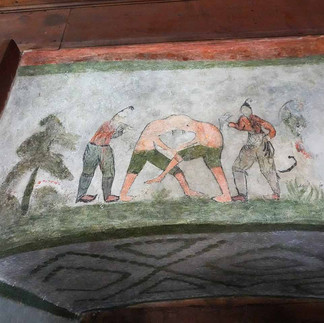













































Comments